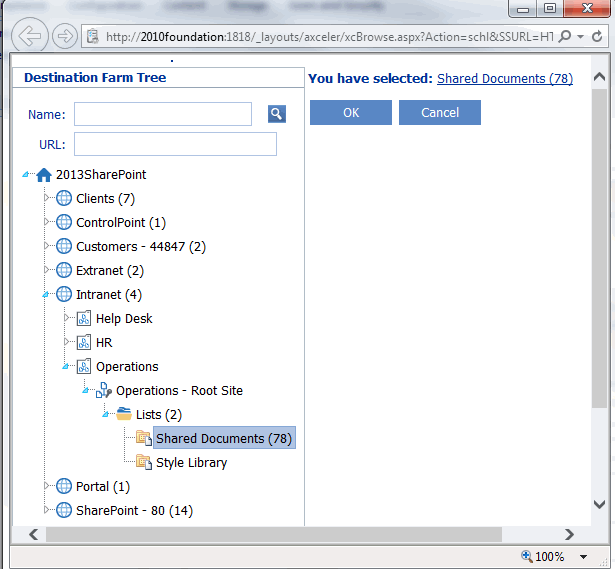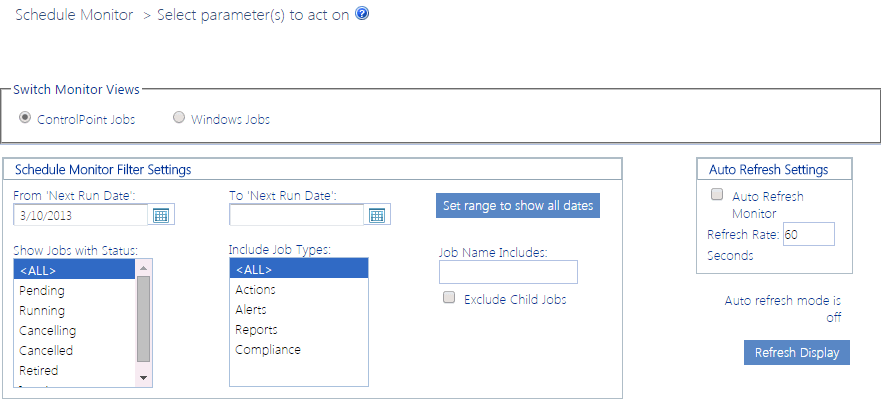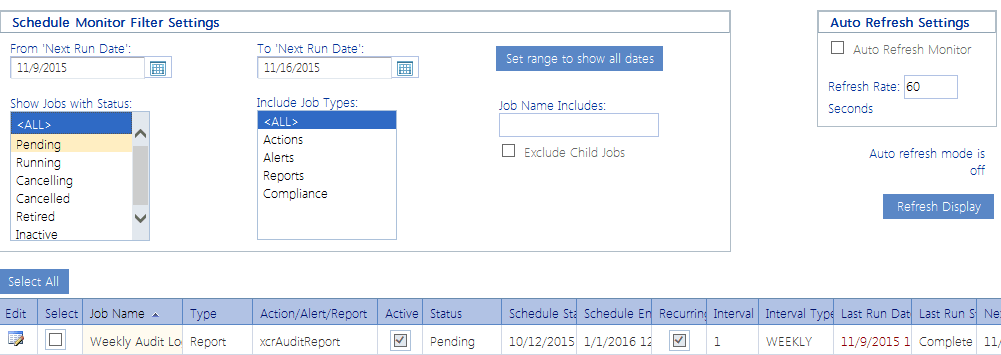Creating a Scheduled Job
To schedule a ControlPoint operation:
1After initiating and specifying the parameters for a ControlPoint operation, open the Schedule section.
Note that, for some ControlPoint operations that are likely to be scheduled for purposes of compliance with corporate or regulatory policy, this section is labeled Enforce Policy.
2Enter a Job Name and Description.
TIP: Choose a brief but descriptive name that uniquely identifies the job. This will make it easier for you to identify it in the Schedule Monitor and Scheduled Jobs Report. If you choose to have the output posted to a SharePoint document library, the Job Name will also be used as the document Title.
3If you want the job to be active, make sure the Active box is checked.
NOTE: Once a scheduled job has been added, it can be activated or deactivated as needed.
4If you want to change the Output File Name, overwrite the default name.
CAUTION: The same default Output File Name is used for every action or analysis of a particular type. For example, whenever you schedule a Site Permissions by Site analysis, the default output file name is xcrRightsBySite, regardless of its scope, or who requested it. It is possible to have more than one job with the same output file name. Keep in mind, however, if more than one job with exactly the same output file name is posted to the same document library, an existing document will be overwritten with a more recent document with the same name.
5For ControlPoint analyses only:
a) If you want the date and time that the job is run to be appended to the file name, click the Include Date Time stamp in the file name box. (This will enable you to retain a historical record of analysis results that may be used as a record of compliance with policies or regulations.)
b)If different than the default, select an Output Type from the drop-down.
NOTE: If you choose CSV, output will be in the form of raw analysis data that can be imported into another program for further examination.
6Complete the Schedule Details as follows:
|
If you want to ... |
Then ... |
|---|---|
|
run an operation one time only |
Enter or select a Start date ( |
|
run an operation at regular intervals |
a.For Start, enter the first date ( b.Click the Recurring box. c.For Run every: ·enter the interval (as a positive integer) at which you want the job to run ·select an interval type (Hour, Day, or Month) d.For Until, enter or select the last date ( |
NOTE: Dates and times correspond to those of the server on which the ControlPoint scheduler is running.
7Complete the Distribution Details. Use the information in the following table for guidance.
|
If you want to ... |
Then ... |
|---|---|
|
have a notification email sent to one or more recipients when the job completes* (and, in the case of an analysis, have output included in the email as an attachment) |
complete the Send to:, Subject, and Message fields. (The From field will automatically be populated with the email address specified when the ControlPoint Online application was originally installed.) NOTE: You can either use the SharePoint People Picker as you would when selecting users on which to perform a ControlPoint action or analysis, or enter one or more email addresses (separated by semicolons), in the Send to field. |
|
have analysis results posted to a SharePoint document library |
Complete the Add to Library or List field as follows: ·Click [Select] to display the Destination Selection Page pop-up dialog, and select a document library from the Destination Farm Tree. (Note that only lists and libraries within the current farm for which you have Full Control access display). ·Select a library from the tree (You can also enter a full or partial Name or URL to narrow your selection). ·Click [OK] to dismiss the dialog and populate the field with the full url path to the selected library. NOTE: When a document is placed into a SharePoint document library, the Output Filename becomes the document Name, and the Job Name becomes the document Title. |
8To save the job, click [Schedule].
Once a scheduled job has been created, it can be accessed via the Schedule Monitor.
Monitoring Scheduled Jobs
The Schedule Monitor lets you view the status of scheduled jobs over a specified date range. From the Schedule Monitor you can link to pages that let you:
·view/edit the details of a scheduled job
·delete scheduled jobs
·link to detailed run history of a job
·update Full Discovery and/or Scheduler windows jobs.
To access the Schedule Monitor:
1From the Manage ControlPoint panel, choose Scheduled Management and Logging > Schedule Monitor.
By default, the Schedule Monitor grid displays jobs that are scheduled to run within the next seven days.
2If you want to change the default date range, do one of the following:
§To include jobs within a specified date range:
a)Enter or select a From "Next Run Date" and To "Next Run Date"
b)Click [Refresh Display].
§To include all jobs regardless of the run date, click [Set range to show all dates].
NOTE: Next Run Date identifies:
§the next date/time a Pending job is scheduled to run
§the last date/time a Retired or Inactive job ran
§the start date/time that an in-process job started running.
3Select one or more Status values from the list box. Use the information in the table below for guidance.
NOTE: You can select multiple status values using the [CTRL] or [SHIFT] in the conventional manner. If you want to view all scheduled jobs for the specified date range, select All.
|
Status |
Description |
|---|---|
|
Pending |
All jobs that are scheduled to run within the specified date range. Pending jobs include: ·one-time jobs that have not yet run AND ·recurring jobs that have not yet reached their End Date. |
|
Running |
All scheduled jobs that are currently running (as long as the specified date range includes the current date). |
|
Cancelling |
All running jobs for which the current instance is in the process of being cancelled. |
|
Cancelled |
All jobs for which the last running instance was cancelled. |
|
Inactive |
Jobs that are not currently active but were created or last ran during the specified date range. |
|
Retired |
Jobs that finished running within the specified date range. Retired jobs include: ·one-time jobs that have already run AND ·recurring jobs that have reached their End Date. |
4If you want to further filter your results, use the information in the following below for guidance.
|
If you want to ... |
Then ... |
|---|---|
|
exclude site admin-specific "sub-jobs" that are created when a scheduled job is created with the Create Reports by Selection Hierarchy box checked |
check the Exclude Child Jobs box. |
|
include only jobs of one or more specific types (Actions, Alerts, and/or Reports) (all job types are included by default) |
highlight the job type(s) you want to include in the list box. |
|
display only jobs whose name includes a specified text string |
complete the Job Name Includes: field with a full or partial job name. |
The Schedule Monitor displays the following information:
·Job Name
·Job Type
·an indication of whether the job is Active (checked) or inactive (unchecked)
·Schedule Status (Pending, Running, Retired, or Inactive)
·Scheduled Start date and time
·the Schedule End date and time which, for recurring jobs, displays the last date and time that the job is scheduled to run.
NOTE: For one-time jobs, the Schedule End date and time (which displays as an hour later than the Schedule Start) has no significance.
·a checkbox indicating whether the job is one-time (unchecked) or Recurring (checked)
·for recurring jobs, the Interval and Interval Type (Hour, Day, Week or Month)
·Last Run Date and time
·Last Run Status (Complete, Failed, Started, Cancelling, or Cancelled)
·Next Run Date, which identifies:
§the next date/time a Pending job is scheduled to run
§the last date/time a Retired or Inactive job ran
§the start date/time that an in-process job started running.
·the User who scheduled the job.
·an indication of whether or not the scheduled job was created with the Run by hierarchy option
·if the job is an instance of a ControlPoint Governance Policy, the name of the Policy Instance.
You can:
·sort by clicking on a column header
·change the order of columns by dragging and dropping.
From the Schedule Monitor you can:
·set the Schedule Monitor grid to Auto Refresh
·open a job for viewing/editing
·cancel or delete one or more jobs
·update Full Discovery and/or Scheduler windows jobs.
Viewing/Editing a Scheduled Job
From the Schedule Monitor, you can access a scheduled job whose details you want to view or edit.
To access a scheduled job's details:
From the Schedule Monitor, click the job's Edit link.
The job opens in a separate browser window.
To edit the job:
1Modify the appropriate fields within the Schedule or Enforce Policy section.
2To save changes, click [Update].
Viewing a Scheduled Job's History
From the Schedule Monitor, you can view the run history of a scheduled job. In the case of scheduled actions (including alerts), you can generate a ControlPoint Task Audit to view more detail about the job.
To view the history of a scheduled job:
·From the Schedule Monitor or Scheduled Jobs Report, click the job's Last Run link.
·From a scheduled job's detail page, click the [View History] button.
The Schedule History includes the following information:
·Run Start date and time
·Run End date and time
·process Status (Started, Completed, or Failed)
·in the case of a Failed job, a Message citing the reason for the failure.
As shown in the example below, a separate entry exists for each run of a recurring job. You can sort by either Run Start or Run End date by clicking the up/down arrows in the column header.
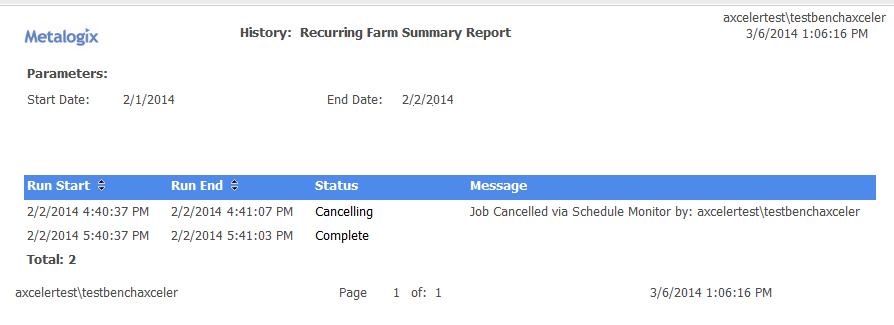
To view a ControlPoint Task Audit for a completed action:
Click the link (Completed or Failed) in the Status column.
See also The ControlPoint Task Audit.
NOTE: This link is valid for actions only (not Discovery or analysis jobs)

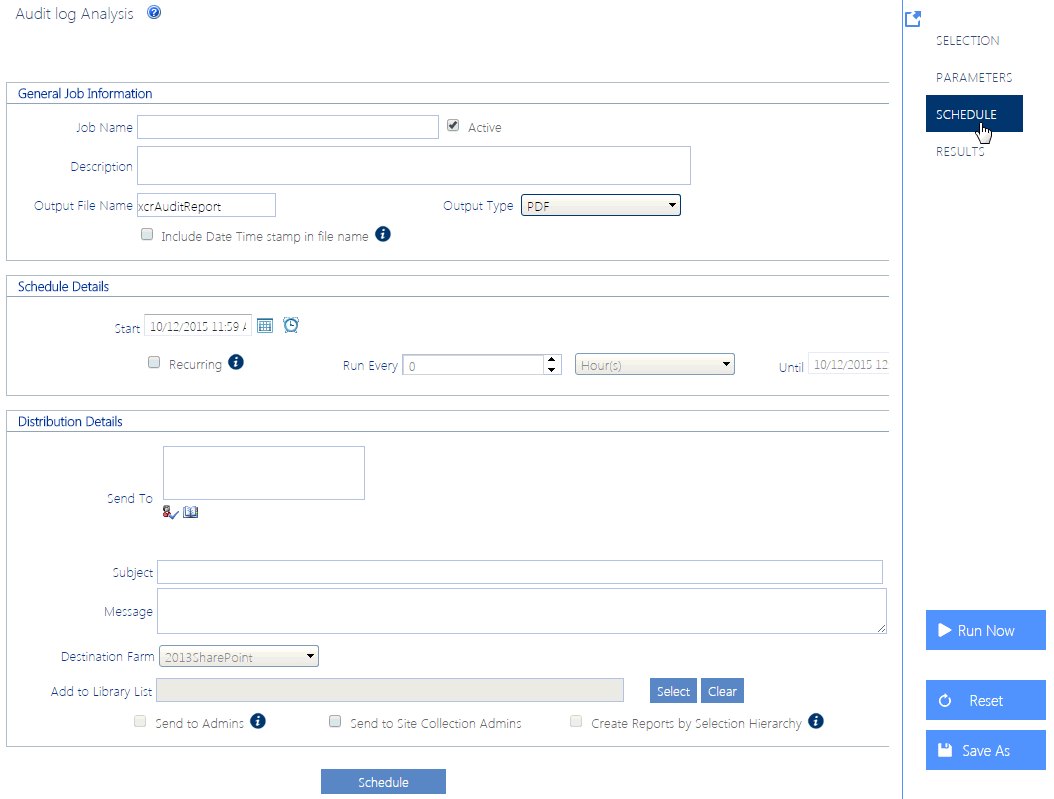


 ) and time (
) and time ( ).
).